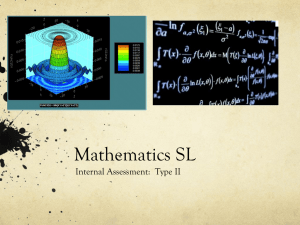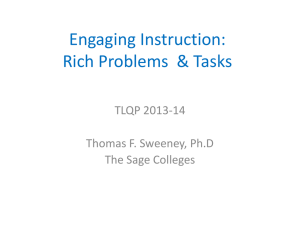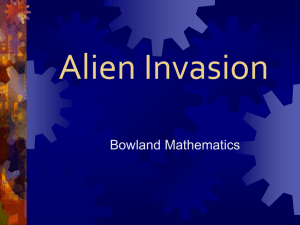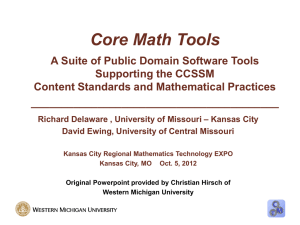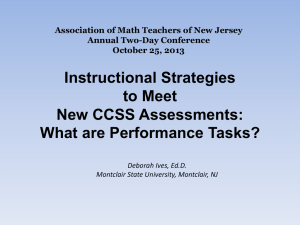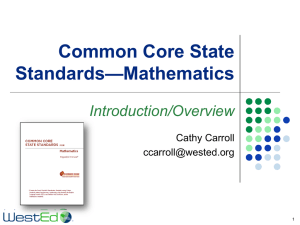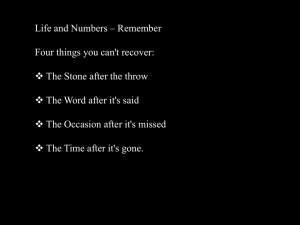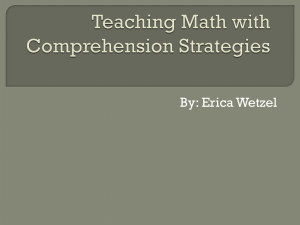Fourth Grade Common Core Math Presentation Feb20
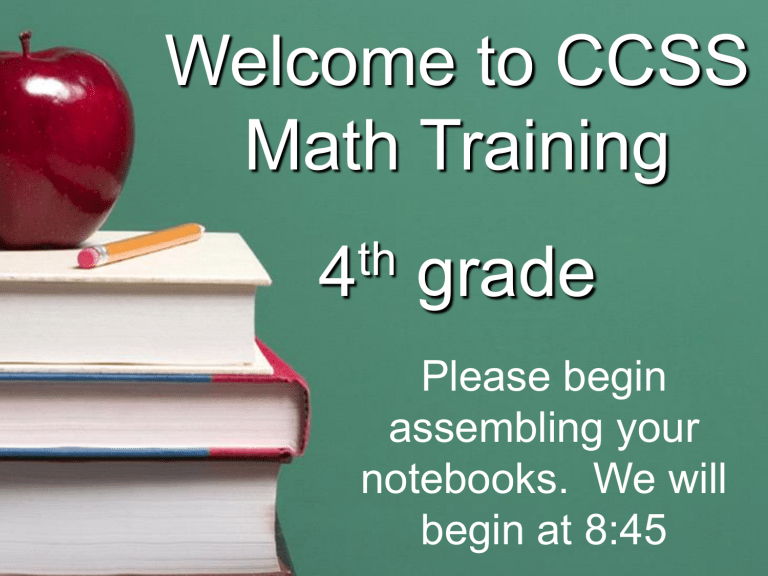
Welcome to CCSS
Math Training
4
th
grade
Please begin assembling your notebooks. We will begin at 8:45
Common Core
State Standards for
Mathematics
Questions? Concerns?
Put them in the parking lot!
Learning Targets
Gain an awareness of the content and structure of the Common Core State
Standards for Mathematics
Understand the meaning of the
Mathematical Practices in the CCSSM and apply the practices to your current classroom instruction
Become familiar with the content standards at your grade level
www.corestandards.org
Common Core Notebooks
Math Section
CCSS & Glossary
Learning Progressions
Unpacking Document
Crosswalk Document
Common Core
State Standards
Design and Organization
Standards for Mathematical Practice
Carry across all grade levels
Describe habits of mind of a mathematically expert student
Standards for Mathematical Content
K-8 standards presented by grade level
Domains:
Number and Operations
Counting and Cardinality
Operations and Algebraic Thinking
Number and Operations in Base Ten
Number and Operations—Fractions
Measurement and Data
Geometry
Standards for Mathematical Practices
1.
2.
3.
4.
5.
6.
7.
8.
Make sense of problems and persevere in solving them
Reason abstractly and quantitatively
Construct viable arguments and critique the reasoning of others
Model with mathematics
Use appropriate tools strategically
Attend to precision
Look for and make use of structure
Look for and express regularity in repeated reasoning
Standards for Mathematical Practice
While the Content Standards describe what mathematics students should be able to understand and do , the Mathematical Practices describe how students should engage with these mathematical concepts and skills.
Mathematical Practices
Mathematical practices describe the habits of mind of mathematically proficient students.
In your classroom,
Who is doing the talking?
Who is doing the thinking?
Who is doing the math?
Standards for Mathematical Practice
2. Reason abstractly and quantitatively
3. Construct viable arguments and critique the reasoning of others
Reasoning and Explaining
4. Model with mathematics
5. Use appropriate tools strategically
Modeling and Using Tools
7. Look for and make use of structure.
8. Look for and express regularity in repeated reasoning
Seeing Structure and Generalizing
Standards for Mathematical Practices
1.
2.
3.
4.
5.
6.
7.
8.
Make sense of problems and persevere in solving them
Reason abstractly and quantitatively
Construct viable arguments and critique the reasoning of others
Model with mathematics
Use appropriate tools strategically
Attend to precision
Look for and make use of structure
Look for and express regularity in repeated reasoning
Design and Organization
Standards for Mathematical Practice
Carry across all grade levels
Describe habits of mind of a mathematically expert student
Standards for Mathematical Content
K-8 standards presented by grade level
Domains:
Number and Operations
Counting and Cardinality
Operations and Algebraic Thinking
Number and Operations in Base Ten
Number and Operations—Fractions
Measurement and Data
Geometry
Design and Organization
Grade Level Overviews
Mathematical
Practices
Design and Organization
Content standards define what students should understand and be able to do
Clusters are groups of related standards
Domains are larger groups that progress across grades
Domain Standards
Grade Level
Content Domains
Illustrative Mathematics Tools http://illustrativemathemati cs.org/standards
Common Core Resources
Glossary
Tables
Common addition and subtraction situations
Common Core Resources
Operations and Properties Tables
Table 3. The properties of operations
Unpacking Document
Crosswalks
Focal Points & Critical Areas
Focal Points
Focal Points & Critical Areas
Critical Area
Time to Reflect
Summary
4th Grade Big Ideas
Angle Activity
Making Wax Paper
Protractors
Investigations Unit 4 Session 3
Take a minute to explore measuring the angles of
Power Polygons.
Trace and record your findings.
Use the measures you discovered to build a shape that contains; a 60 degree angle a 120 degree angle a 150 degree angle
Record your findings by tracing the combination of polygons you used to create each angle listed above.
Be sure to carefully label your drawings.
A Technology Resource for Angles http://primarygamesarena.com/Banana-Hunt2631
Time to Reflect
Summary
Scavenger
Hunt 1. What grade is the standard algorithm for multiplication taught?
2. What grade introduces the concept of probability?
3. What grade level introduces money?
4. What grade level introduces fractions?
5. By the end of what grade should students memorize multiplication facts with products to 100?
6. What grade is responsible to teach the eight mathematical practices?
7. Line symmetry is introduced in what grade?
8. What grade are the concepts of area and perimeter taught?
Scavenger
Hunt
Answers
1. What grade is the standard algorithm for multiplication taught? 5 th grade
2. What grade introduces the concept of probability? Not in elementary
3. What grade level introduces money?
2 nd grade and it builds through the years
4. What grade level introduces fractions? 3 rd grade
5. By the end of what grade should students memorize multiplication facts with products to 100? Third grade
6. What grade is responsible to teach the eight mathematical practices? All of them!
7. Line symmetry is introduced in what grade?
4 th grade
8. What grade are the concepts of area and perimeter taught? 3 rd grade
What’s In
Factors and Multiples (4.OA.4)
Multiply a fraction by a whole number (4.NF.4)
Conversions of measurements in the same system (4.MD.1 and
4.MD.2)
Angles and Angle Measures
(4.MD.5, 4.MD.6, 4.MD.7)
Lines of Symmetry (4.G.3)
Coordinate system (3.01)
Transformations (3.03)
Line graphs and bar graphs (4.01)
Data – median, range, mode, comparing sets (4.03)
Probability (4.04)
Number relationships (5.02, 5.03)
What’s Out
Challenges for Next Year
What concepts need to be addressed in order to help students transition to the new math standards?
Gaps
Will not have exposure to the basics of area and perimeter
Bar graphs (scaling and analyzing)
Challenges
Students may not have foundational knowledge in fractions to multiply
Time to Reflect
Summary
Investigations Alignment
How will Investigations align with the new
Common Core State Standards?
http://investigations.terc.edu/CCSS/
Goals of Investigations
Support students to make sense of mathematics and learn that they can be mathematical thinkers.
Focus on computational fluency with whole numbers as a major goal of the elementary grades.
Provide substantive work in important areas of mathematics— rational numbers, geometry, measurement, data, and early algebra—and connections among them.
Emphasize reasoning about mathematical ideas
Communicate mathematics content and pedagogy to teachers.
Engage the range of learners in understanding mathematics.
Investigations and the CCSS
Close alignment between Investigations & the CCSS
New work builds on and extends the existing work within the grade level.
Some sessions have been omitted to allow for new material.
Mathematical Practices are aligned with the goals and principles of Investigations and deeply embedded in the fabric of the curriculum.
The Investigations curriculum when taught as intended, offers students and teachers coherence, focus, clarity and specificity in the teaching and learning of mathematics.
“ While the CCSS Content Standards describe what mathematics students should be able to understand and do, the mathematical practices describe how students should engage with these mathematical concepts and skills. The Investigations curriculum is intentionally designed to promote a deep understanding of mathematics and develop mathematically proficient students who can think, reason, model and solve problems.
”
(Standards for Mathematical Practices in Investigations in Number, Data and Space, p. 6.)
Grade Level Adaptations
Using Investigations to Implement the Common Core – November 4, 2011
Investigations Alignment
Resources:
Investigations and the
Common Core State Standards
Also found online www.pearsonsuccessnet.com
Investigations Alignment
www.pearsonsuccessnet.com
Investigations and the CCSSM
Companion materials to Investigations
Investigations and the Common Core State Standards
Each grade level resource book contains:
An instructional plan for adapting existing content and adding new content
Teacher and student materials for new content
Sessions, Classroom Routines/TMM, Teaching/PD Notes,
Resource Masters, Assessments
Detailed correlations between Investigations and
Mathematical Practices and Content Standards
“Snap-in” Instructional Plan Tabs for each unit
How the New Content is Addressed
Teaching/Math Notes
Ten Minute-Math/Classroom Routines
Homework & Practice Pages
Sessions
Content & Pacing
Try this!
1.
Work together to use all seven tangram pieces to build a square.
2.
The square will represent our whole in today’s activity.
3.
Next, work together to figure out the fractional size of each tangram piece.
Reflecting on the Task
What makes this activity a good task?
What mathematical practices are reinforced with this activity?
What content standards or big ideas are addressed?
Video
Fractions with Geoboards http://www.learner.org/vod/vod_window.html?pid=9
05
Time to Reflect
Summary
CCSSM Resources
Books
Magazines
Technology Resources
DPI Wiki
http://www.ncdpi.wikispaces.net/ http://maccss.ncdpi.wikispaces.net/home
CCSSM Resources
Common Core State Standards Live Binder: http://www.livebinders.com/edit?id=133724
Resources:
21 st Century Skills
Common Core State Standards & Essential Standards
Crosswalks
Unpacking Documents
Investigations & CCSSM
Websites
Unpacking Document
Math Resources
Aegom Interactive Smartboard Lessons www.aegom.com/
Video Resources
Annenberg Media Videos & Resources
http://www.learner.org/resources/ browse. html?discipline=6
Discovery Education/United Streaming
http://streaming.discoveryeducation.com/
Math Resources
National Council of Teachers of Mathematics (NCTM) www.nctm.org
http://illuminations.nctm.org/
Teaching Children Mathematics
Magazines
Math Resources
SMART Exchange http://exchange.smarttech.com/index.html#tab=0
netTrekker http://school.nettrekker.com/authenticate/ipauth/1?np
=/home.ftl&pp=/ipauth_error.ftl
Common Core Resources
ACRE: Common Core State and Essential Standards http://www.ncpublicschools.org/acre/standards/
ACRE: Instructional Support Tools http://www.ncpublicschools.org/acre/standards/support-tools/
Tools for the Common Core Standards http://commoncoretools.wordpress.com/
Illustrative Mathematics (CCSS Tools & Resources) http://illustrativemathematics.org/standards
Common Core Wiki (by Drew Polly) http://elemath.pbworks.com/w/page/30621644/common-core
National Council of Teachers of Mathematics www.nctm.org
www.nctm.org/standards/mathcommoncore/
Math Resources
Revisiting the Parking Lot
Let’s address any questions from the parking lot…
Time to Reflect
Summary
